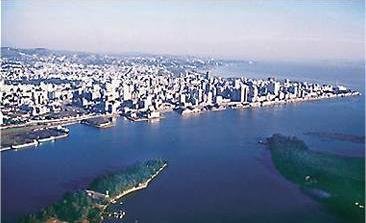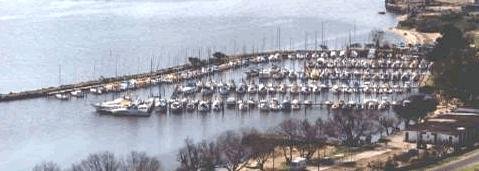


Porto Alegre?...
Guaíba?...
|
See on this page where we are on the planet and know something about us. Porto Alegre has 1 million and so inhabitants and is the capital of Rio Grande do Sul, the southern state of Brazil. |
 |
 |
People born here is called Gaúcho (pronounced like ga-'u-sho). We have a typical regional culture including food (like the barbecue), vocabulary and way of life. |
|
We are about 75 road miles (120km) to the West of the coast of the Atlantic Ocean. Something like W51º10' S30º 00' The weather is sub-tropical: cold on the winter and hot on the summer but not that much extreme like New York. The gaúchos are known by their hospitality and friendliness. German and Italian colonization in our state in the 19th century left important cultural influences. |
 |
|
The Guaíba is created by some other rivers and goes to the Lagoa dos Patos ("Duck Lagoon"), a really big lagoon that reaches the Atlantic Ocean in the city of Rio Grande (an important commercial port of the region).
|
 |
 |
There are about 750 sailboats moored on the main yatch clubs of the city, from 17' to over 50'. Many other small sailboats, from Optimists to Lasers, 470, Solings, etc, under rooves. Also about 500 motorboats - from inflatables to big trawlers. Because the river has commercial traffic, it's canal is 20ft deep along all the extension. |
|
Porto Alegre is well known for its sail world champions. Among them, Boris Ostergren and Ernesto Ari Neugebauer, the winners of The World Snipe Championship, Denmark, 1977. See the (not so) old guys, 20 years after Denmark on a Snipe regatta against a lot of boys in the Guaíba. |
 |
Lately the river is being called a lake by the authorities. But some years ago they said it was an estuary. I don't care. River is OK. Who cares? I'm not old enough to sail lonely, but I am old for these boring 'fashions'. Look to the satellite pictures below and call it the way you want.
Lagoa dos Patos, Guaíba
and Porto Alegre
NASA publishes a geographical quiz. The image above was used in one of them. Here are the questions and answers.
1. The large lagoon in the image is named for a particular type of bird. Name the bird.
The "Lagoa dos Patos", in the Brazilian state of Rio Grande do Sul, translates to "the Duck Lagoon". It was named by 16th century Jesuit settlers, who asked the King of Spain to grant them title to the lagoon so that they could breed ducks. The King consented, but revoked his edict when he discovered that the "duck-pond" (measuring about 14,000 square kilometers) was one of the largest lagoonal systems in the world.
2. Note the sediment plume emanating from the southern end of the lagoon. Sailors in the 16th century imagined this outlet to be the mouth of a large river. What did they call the river?
Early Portuguese explorers mistook the entrance to the lagoon for the mouth of a great river and called it the Rio Grande.
3. A series of wave-like points and curls form "cusps"
on the inner shores of the lagoon. Which ONE of the following is most responsible
for the formation of these cusps?
(A) Violent storm impacts on erosion and accretion
(B) Wind and tide-driven sediment transport and circulation
(C) Tectonic folding associated with nearby mountain ridges
(D) Bathymetric effects of dredging operations
Answer: B
The lagoon's characteristics change with short-term tide-induced cyclic
perturbations, and with longer term large scale meteorological conditions.
The distinctive wavelike "cusps" along the inner shores result from
the circulation, erosion and accumulation of sediments driven by wind and
tidal action.
4. True or false: Changes in regional precipitation associated with large scale atmospheric circulation patterns have no effect on the salinity of the lagoon's water.
Answer: FALSE
The El Niño Southern Oscillation (ENSO) circulation affects precipitation
amount and continental runoff, thereby changing the contents of the lagoon
waters. High rainfall and increased freshwater discharge of El Niño
correspond with elevated dissolved nutrient concentrations and increased phytoplankton
growth. La Niña years are dry, and low rainfall reduces the freshwater
recharge to the lagoon, causing an increase in salinity.
5. Which one of these is NOT distributed within the area covered
by this image?
(A) Ruppia maritima
(B) Chelonia mydas
(C) Tapirus bairdii
(D) Microcystis aeruginosa
Answer: C
Occasional blooms of toxic cyanobacteria (Microcystis aeruginosa), have
been registered in the lagoon when nutrient concentrations are elevated. A
number of reeds and grasses are important to the lagoon estuary, including
widgeon grass (Ruppia maritima) which reaches peak production during summer.
Sea turtles (Chelonia mydas) can be found in the lagoon during spring and
summer. Although the lowland tapir (Tapirus terrestris) is found in some parts
of Rio Grande do Sul, the Baird's tapir (Tapirus bairdii), is not distributed
within the image area (it is restricted to Central America).
See another satellite pictures of the Lagoon and region
MISR, launched in 1999
by NASA

This is the author of the bigger pic above